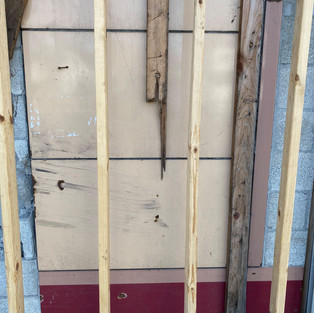A Mayan Temple on Gratiot
- Castle Museum

- Jan 4, 2021
- 2 min read
If you have been driving on Gratiot Avenue recently, you may have noticed that a couple of panels of the black covering on the commercial building located at 933 are missing and the original porcelain coated steel has been exposed. While this small section only hints at the original appearance, it serves as a connection to the story of a theater design inspired by its architect’s travels to the Yucatan peninsula.
Completed in February 1938, 933 Gratiot was constructed as a neighborhood theater named the Marr. When it opened, an article in the Saginaw News described the theater in detail:
“Designed in the Mayan architectural style, the bright interior of the new Marr theater, 933 Gratiot Avenue, resembles a temple of that ancient American race. Soft colors have been blended carefully and indirect lighting arranged skillfully to give the best possible effect. Red plush seats provide comfortable seating for 700 persons.”
“The exterior of the buildings is as colorful and attractive as the interior. The facing of Metal-On, a porcelain-enamel substance, and the base color is cream with trimmings of wine, rose and yellow.”
The Saginaw News, February 10, 1938
The article continues, noting the building was designed by Saginaw architect Samuel Allen. Born in Saginaw in 1895, Allen attended the University of Michigan and the Massachusetts Institute of Technology. He designed several commercial and public buildings in his home city and other Michigan communities. In 1966, he was named Member Emeritus of the American Institute of Architects. In 1934 – 4 years prior to designing the Marr - he toured and photographed Mayan ruins. Upon returning, he gave numerous presentations describing the buildings he had seen. His programs were illustrated in his photographs.
Although no photographs of the interior have been located, memories of theatergoers of a certain age suggest that the Mayan motif was subtle but clearly recognizable. The one exterior newspaper photograph we were able to locate, shows a simple exterior enlivened with glass block and Art Deco details. It does not take much imagination to imagine that some of these details were inspired by designs that Samuel Allen had seen during his travels.
In 1970, the Marr Theater was converted into retail space accommodating three stores and in 1972, Samuel Allen passed away in Florida.
A photograph of the exterior of the Marr Theater is featured in Stories of Saginaw’s Silver Screens. The exhibit will be open for a brief time after the Castle Museum reopens on January 4. Although the exhibit will need to close for the traveling exhibit from the Smithsonian, it will reopen in early May.
If you have historic photographs of the Marr Theater, please contact Tom Trombley: phone: 989-752-2861 ext. 304; email: ttrombley@castlemuseum.org.










Hozzászólások